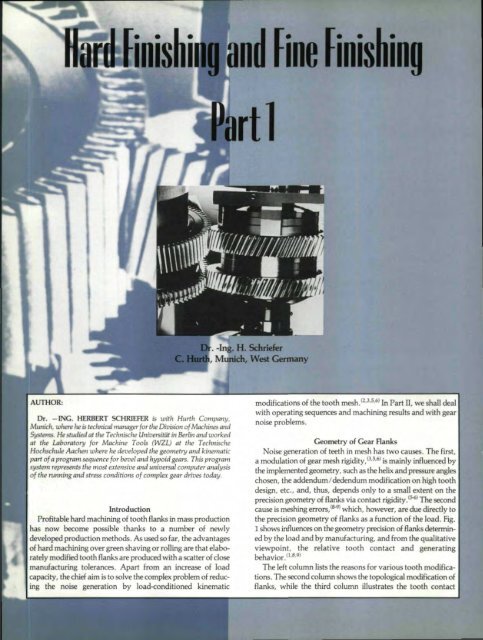Download the September/October 1989 Issue in PDF format - Gear ...
Download the September/October 1989 Issue in PDF format - Gear ...
Download the September/October 1989 Issue in PDF format - Gear ...
You also want an ePaper? Increase the reach of your titles
YUMPU automatically turns print PDFs into web optimized ePapers that Google loves.
nd F<strong>in</strong>e F<strong>in</strong>ish<strong>in</strong>g<br />
rt 1<br />
. -Ing, H. Sc:hrieler<br />
Munich, West Germany<br />
Dr. -ING. HERBERT SCHRIEfER is with Hurth Company,<br />
Munich, where he is technical manager for <strong>the</strong> Division of Mach<strong>in</strong>es and'<br />
Systems. He studied' at <strong>the</strong> Technische Unrvmitiit <strong>in</strong> Berl<strong>in</strong> and' worked'<br />
at <strong>the</strong> Laboratory for Mach<strong>in</strong>e Tools (WZL) at <strong>the</strong> Technische<br />
Hochschule Aachen where he developed <strong>the</strong> geometry and k<strong>in</strong>ematic<br />
part of a program sequence for bevel and hypoid' gears, This program<br />
system represents <strong>the</strong> most extensive and universal computer analysis<br />
of <strong>the</strong> runn<strong>in</strong>g and stress conditions of complex gear drives today.<br />
Introduction<br />
Profitable hard mach<strong>in</strong><strong>in</strong>g of tooth flanks <strong>in</strong> mass production<br />
has now become possible thanks to a number of newly<br />
developed production methods. As used so far. <strong>the</strong> advantages<br />
of hard mach<strong>in</strong><strong>in</strong>g over green shav<strong>in</strong>g or roll<strong>in</strong>g are that elaborately<br />
modified tooth flanks are produced witha. scatter of dose<br />
manufactur<strong>in</strong>g tolerances. Apart from an. <strong>in</strong>crease of load<br />
I cap.acity, <strong>the</strong> chief aim.is to solve <strong>the</strong> complex problem of reduc-<br />
I <strong>in</strong>g<strong>the</strong> noise generation by load-conditioned k<strong>in</strong>ematic<br />
modiJications of <strong>the</strong> tooth mesh.'us,o) In Part Il, we shan deal<br />
with operat<strong>in</strong>g sequences and mach<strong>in</strong><strong>in</strong>g results and with gear<br />
noise problems.<br />
Geometry of <strong>Gear</strong> Flanks<br />
Noise generation of teeth i.nmesh has two causes. The first.<br />
a modulation of gear mesh rigidity, (3.5.6) is ma<strong>in</strong>ly <strong>in</strong>fluenced by<br />
<strong>the</strong> implemented geometry, such as <strong>the</strong> helix and pressure angles<br />
chosen, <strong>the</strong>addendum/dedendum modification on high tooth<br />
design, etc.. and, thus .•depends only to a small extent on <strong>the</strong><br />
precision geometry of flanks via contact rigidity. (~) The second<br />
cause is mesh<strong>in</strong>g errors, (8-9) which, however, are due directly to<br />
<strong>the</strong> precision geometry of flanks asa function of <strong>the</strong> load. Fig.<br />
1shows <strong>in</strong>fluences on <strong>the</strong> geometry precision of flanks determ<strong>in</strong>ed<br />
by <strong>the</strong> load and by manufactur<strong>in</strong>g, and from <strong>the</strong> qualitat:ive<br />
viewpo<strong>in</strong>t. <strong>the</strong> relative tooth contact and generat<strong>in</strong>g<br />
behavior. (1.8.9)<br />
The left column lists <strong>the</strong> reasons for various tooth modifications.<br />
The second column shows <strong>the</strong> topological modificati.on of<br />
flanks, while <strong>the</strong> third column illustrates <strong>the</strong> tooth contact

















